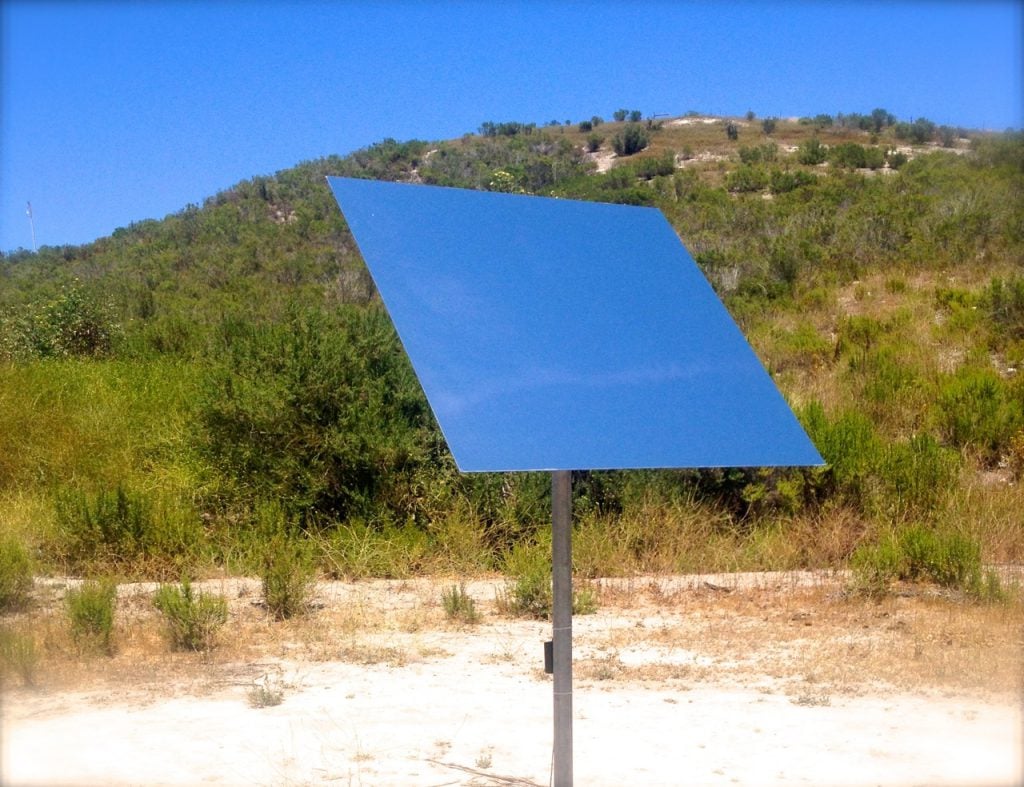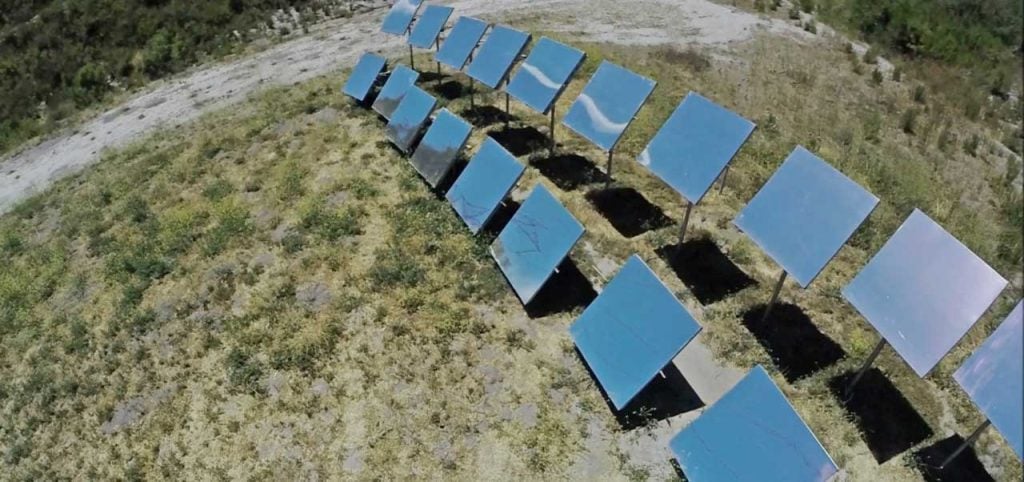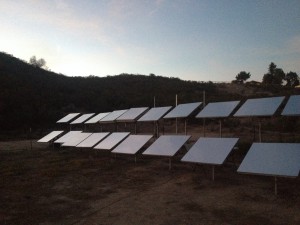
Heliostats are computer-controlled mirrors which keep the sun reflected on a target as the sun moves across the sky. The LightManufacturing H1™ heliostat delivers up to 1300 watts of heat to a target – or up to 150,000 lumens for lighting applications. The H1 offers the lowest cost-per-reflected watt of any commercially available heliostat. Easy setup, optional wireless control.
Combine multiple H1 heliostats for unlimited heating & lighting power. The H1 moves rapidly between targets – useful for sustainable manufacturing applications or residential day-lighting or building heating. LightManufacturing’s general purpose H1 Heliostat is simple, low cost, and reliable. New option: Vacuum Adjustable 100x Concentrating Mirror The H1 joins your WiFi network, and is configured and targeted using your smart phone or web browser. No special software required! Once targeted, the on-board computer tracks the sun and keeps the reflection on-target – your phone or browser is no longer needed.



Media List (left): Video showing real-time heliostat movement Still photo, H1 heliostat Beach Testing, Long-Range Reflection Home Use – Before / After Lighting Application (one H1 heliostat)
An apparatus containing a movable or driven mirror, used to reflect sunlight in a fixed direction. As the sun moves across the sky, a heliostat makes small adjustments to the position of a mirror in order to keep reflected light on a target. The larger the mirror mounted on the heliostat, the more energy and light is delivered to the target. Multiple heliostats can reflect light onto the same target to deliver large amounts of heat and light. LightManufacturing manufactures the high performance H1 Heliostat.



Yes! But understand: mirror size makes a big impact on shipping costs.
* Disclaimer: shipping prices are estimates only and are not guaranteed, and were provided as of 5/2020. Do not rely on these figures – get a formal quote from us!
We’re often asked where heliostats can be installed. While there are some great software tools to help ( https://www.suncalc.org/ ), there’s a simple process anyone can follow.

Note that you should check morning, midday, and afternoon to be sure you can reflect light throughout the day.
 Note also that the sun’s path will change with the seasons – remember how the sun’s path differs at other times of the year. Use a tool like https://www.suncalc.org/ to check the path for different pats of the year.
Note also that the sun’s path will change with the seasons – remember how the sun’s path differs at other times of the year. Use a tool like https://www.suncalc.org/ to check the path for different pats of the year.
DISCLAIMER: This process depends on you doing it correctly, is for informative planning purposes only, and we don’t guarantee results without a formal, paid solar survey. This said, for most projects the above method is a useful preview of the H1 heliostat’s performance at your location.
Heliostats are the most efficient and low-cost way to harness solar energy. The uses for heliostats include:
The standard H1 heliostat ships with a 1.21M x 1.21M (48″ square) aluminum composite reflector.
In contrast to the H1, some smaller / consumer-oriented heliostats offer a mirror only .5 square meters in area, reflecting @ 425 watts of energy. It would take 4 or 5 of these small units to equal one H1 heliostat.
The LightManufacturing H1 heliostat is a powerful commercial-grade heliostat, with a number of advantages over ‘home heliostat’ systems.
Yes. Heliostats are a low cost way to capture light and heat and direct it into a building through windows. In many buildings, some rooms never get direct sunlight at all – they face the wrong way. Heliostats placed outside these cold /dark rooms can direct warmth and light into the rooms, transforming them into enjoyable, comfortable spaces. Each H1 Heliostat can deliver over 1000 watts to a room, or over 115,000 lumens of light. Multiple H1s can be combined to warm a single room faster, or you can use several H1 heliostats to warm different spaces simultaneously. Applications include schools, office buildings, homes, industrial workspaces, farm buildings, and many other architectural uses.
The H1 Heliostat is available for sale at our heliostat order page ( click here ). The H1 heliostat is available for sale to the general public in several configurations, and we also offer sales programs for commercial customers with volume purchasing needs.
Yes. In fact, heliostats like the LightManufacturing H1 are one of the simplest ways to add sustainable, low-cost solar heat and light to a new green building project, infill project, or retrofit. Heliostats are low cost, and supply heat and light through existing building windows. » Read more about heliostats for LEED / green building applications.
The H1™ heliostat employs a aluminum composite reflector which is more reflective than the best glass mirrors, but is safe, shatterproof and lower cost. A Vacuum-Focus mirror option (US Patent 9,575,222) allows for 100x concentration of the light for intense heating. The H1 incorporates advanced features including wifi-based wireless remote control and configuration (browser-based, no software required), integral microprocessors, and available on-board solar power systems.
The H1 uses a precise two-axis worm-drive system and stepper motors for accurate positioning.
The LightManufacturing H1 heliostat is an industrial-grade heliostat that combines robust performance with easy setup and operation – and at the lowest price per reflected watt of any heliostat on the market. Simply put, it costs less to heat a target with the H1 that with any other solution.
Yes – if you have a flat plate thermal collector (for example, for making hot water or hot air) the LightManufacturing H1 heliostats can help. Fixed position flat plate collectors typically do not work well in the morning or later afternoon, because they are installed in a ‘best average’ position to maximize mid-day solar absorption. This means less hot water or hot air at non-peak times. Solution: Use h1 heliostats to direct solar energy to your flat plate collector at off-peak times.
However- in many cases the additional cost of adding a heliostat to a fixed flat-plate collector may not make sense. Each case is different.